What is depression?
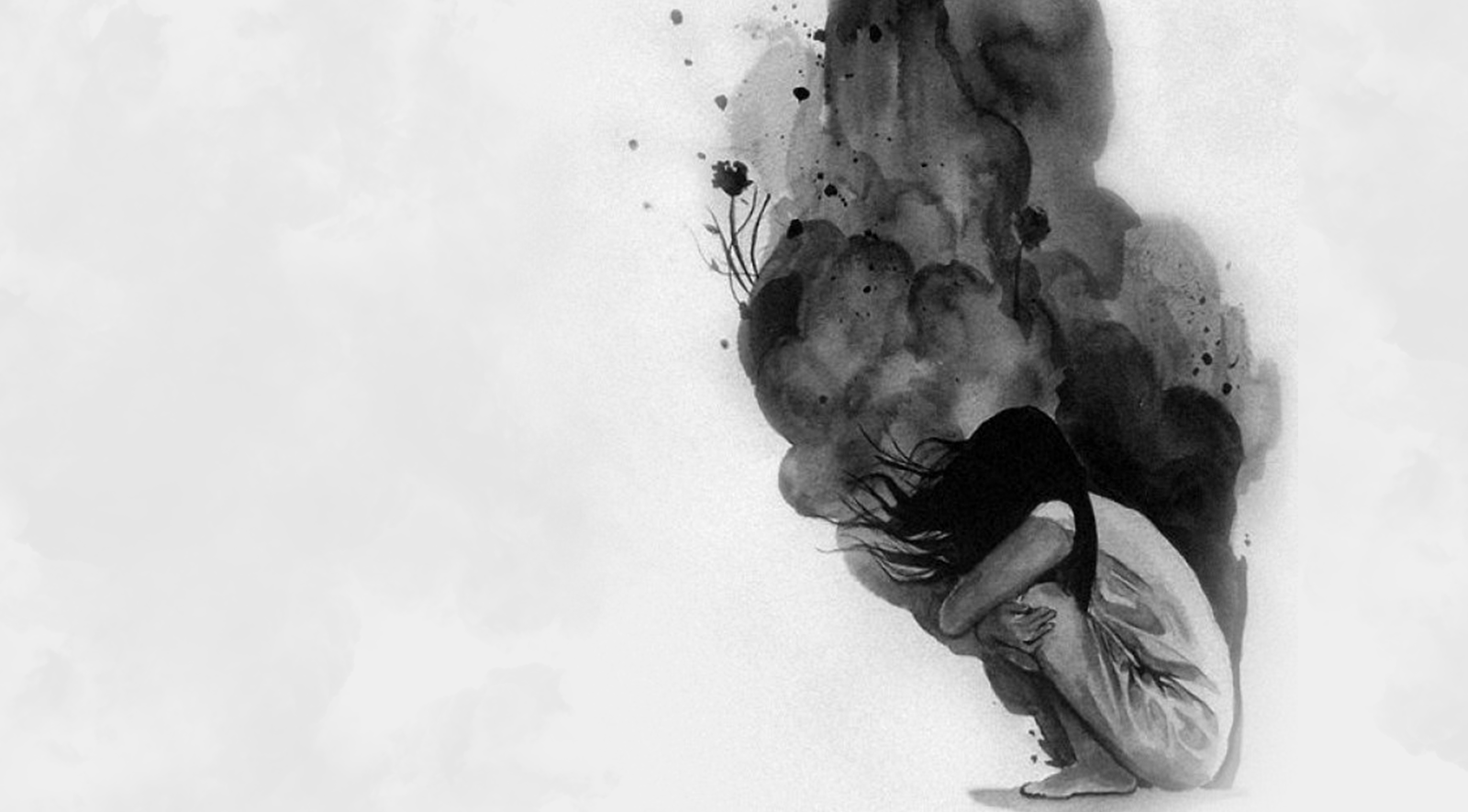
The word depression is used in everyday language to describe feelings of sadness, frustration, and disappointment. Though everyone at some point will experience these emotions, when we discuss depression in a clinical sense these feelings are more intense, last longer (two weeks or more), and significantly impact your day-to-day life.
Depression as a Syndrome
Depression as a syndrome is the collection of behaviours and feelings characterising depressed people as a group. Individual differences will all influence the number of symptoms and the extent of the symptoms that are experienced.
-
-
- Depression is seen as a disorder of mood
- Low mood that has continued for more than 2 weeks are described by individuals who are depressed
- In mild cases of depression an individual may not feel bad all day, but may still have a negative outlook and sense of gloom. When positive events occur their mood will increase, however will drop even with a minor disappointment
- In severe cases of depression the low mood could occur throughout the entire day. Even experiencing pleasant events can have no impact on the individuals mood
- Besides sadness, anxiety is another mood common to depression
-
-
-
- Depressed individuals tend to think in certain negative ways
- Individuals who are depressed generally view themselves negatively and will continually focus on how difficult life is, a hopeless view of the future, and things might never get better
-
-
-
- Blame themselves for everything (including the negative way in which they think)
- Very low Self-esteem and self-confidence
-
-
-
- Difficulty in falling sleep
- Disrupted sleep patterns
- Interrupted sleep
- Increased time spent sleeping and difficulties in staying awake
- A decline in appetite leading to weight loss in some individuals
- Others may have an increased appetite and gain weight
- Possibility of decreased libido
- Low energy levels which lead to individuals doing things they originally enjoyed due to feeling lethargic or unmotivated
-
- Many depressed individuals tend to express concerns about their personal relationships
- They may become dissatisfied and unhappy with their close relationships like family
- They may feel anxious and shy with other people, magnified in group settings
- Feelings of being lonely and isolated while simultaneously not being able or unwilling to reach out for others even if presented with the opportunities
What causes depression?

There are a combination of contributing factors that may cause depression, with two broad categories that include biological and psychological factors interacting with each other.
-
-
- Depression often runs in families, suggesting that genes that make an individual more vulnerable to depression may be inherited
- Depression itself is not necessarily inherited, however it can be an increased vulnerability towards the illness
- Many individuals may inherit depressive vulnerabilities but may never suffer from a depressive illness
-
-
-
- There are some hormonal changes that occur in depression
- Prior to and during a depressive episode, the brain goes through some changes affecting certain parts
- This may lead to an over or under production of some hormones, accounting for some symptoms of depression
- Medication treatments have shown to be effective for these conditions
-
-
-
- The nerve cells in the brain communicate with each other via a chemical substance known as a neurotransmitter
- During depression there is believed to be reduced activity of neurotransmitter systems
- This can affect certain areas of the brain which control sleep, appetite, libido, and possibly mood.
- This reduced level of transmitters results in reduced communications between never cells and may account for the typical symptoms of depression.
- There are many anti depressant drugs that are aimed to increase the neurotransmitters in the brain
-
Depression is closely associated with many thinking patterns that include:
-
-
- Over focus of the negative
- Taking responsibility of negative events but not for positive events
- Having inflexible rules about how someone should behave
- Believing that others are thinking badly of you
-
When individuals experience events where loss occurs, depression can be brought about. Events that include loss of a loved one, loss of a job, loss of a friendship etc.
-
-
- Some individuals base their happiness solely on whether or not they achieve their goals
- If they are unable to achieve these goals, these individuals may believe they have failed in some sense
- It is this feeling of failure that may bring about or increase depression
-
There are many stressful situation in life that may bring about depression and these may and are not limited to:
-
-
- Unemployment
- Financial worries
- Serious relationship issues with a spouse, parents, or children
- Physical illness
- Major changes regarding life circumstances
-
Psychotherapy for Depression

Besides treatments like antidepressant medication and electroconvulsive therapy, depression can also be treated with Psychotherapy. These therapies have been evaluated and be shown to be effective with evidence-supported therapies such as cognitive therapy and behaviour therapy being the most common types.
The aim is to help individuals realise they can alter their mood by finding and changing their thoughts and beliefs.
-
-
- When an individual is depressed, they often think very negatively regarding themselves, their life, and their future
- Thinking like this further worsens their mood
- Cognitive therapy aims on finding and challenging unhelpful beliefs and assumptions while developing more helpful and balanced thoughts
- Cognitive therapy is focused on the there-and-now
- This type of treatment has been shown to be effective when individuals are able to acquire skills that are taught during therapy
-
Behaviour therapy aims to identify and change certain behaviours that contribute to the worsening of depression. Depressed individuals tend to feel unmotivated and lethargic causing them to stay at home, and avoiding people which in turn can cause them to miss out on mood lifting opportunities.
Some behavioural strategies to consider:
-
-
- Goal setting
- Activity scheduling
- Social skills training
- Structured problem solving
-
The Cycle of Depression
Depression symptoms bring about certain drastic changes in a depressed person’s daily life. This can include drastic changes regarding their life, daily routines, and their behaviour. It is often that these changes make the depression worse, and prevent the depressed person from getting better.
If you find that you have become less active, not going out as much, avoid hanging out with friends, and stopping engaging with your favorite hobbies, you may find yourself being locked in to a cycle of depression as illustrated above.
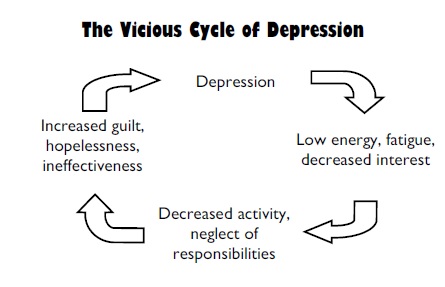
-
-
- When your activity level decreases you may become more lethargic and unmotivated
- If you stop doing things that you enjoy, the opportunity to experience pleasant feelings and positive experiences will be missed
- This can cause your depression to get worse
-
Methods like medication like antidepressants can change your energy level and improve sleep. Increasing activity level by engaging in pleasurable activities and accomplishing your list of responsibilities and tasks in a realistic and achievable way so that you are set up for success.
Increased activity can help you:
-
-
- Feel better
- Feel less tired
- Think more clearly
-
Eventually when the depression cycle has been broken, it will look like:
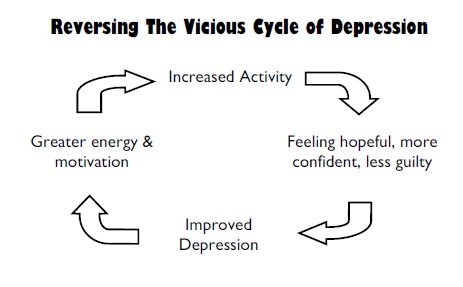
We have included some resources below to help with breaking the cycle of depression.
Improving how you feel

It is not the situation or words and actions of someone else, but actually how we perceive the situation or the actions of that person. It is therefore our thoughts and beliefs that influence our feelings and actions.
When we are happy and excited, we tend to have been thinking positive thoughts and things. If we feel anxious, depressed, and upset the likelihood that we have been thinking negative thoughts is likely. It is normal for all of us to think of things that make us feel sad or anxious, however if you are often upset or distressed you may need to examine your thinking to improve how you feel.
Feelings and thought are easily confused but it is more helpful to separate them. For example if you hear someone saying “I think I’m anxious”, they feel anxious and may be thinking thoughts that “Everyone will laugh at me”.
Unhelpful thoughts are ones that tend to focus on:
-
-
- Negative aspects of a situation
- Overestimate the chances of a negative event occurring
- Thoughts that place unrealistic demands on yourself or others
-
There are many things that you can do to feel better.
Step 1 – Identify how and what you are feeling
-
-
- Then ask “What am I thinking?” and “What conclusions am I making?”
- This can help you see why you are feeling distressed.
-
Step 2 – Challenge your thinking by exploring other explanations
-
-
- What are some other ways of viewing this situation?
- How would someone else in this same situation view it?
- Could there be any other explanations?
-
Step 3 – Take into account these other viewpoints by revising my original thoughts
-
-
- Think of another explanation
- This can become your new helpful and balanced thought
- A balanced thought is one that takes into consideration the different viewpoints which help you feel better.
- Replace the original, unhelpful thought with this new viewpoint and you will find that you feel better and your mood will increase.
-
Thinking and Feeling
It is sometimes difficulty to put into words what we are feeling and we are unsure as to what we feel. If you look below there is a list of words to describe feelings which may help you understand the connection between thinking and your feelings.
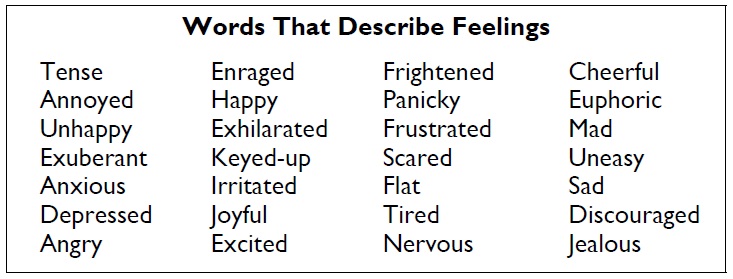
Some of our thinking is so habitual that like driving becomes an automatic process causing us to not be conscious of it. As our brains are constantly turning over ideas and thoughts, we are not consciously aware as it happens relatively fast. Our automatic thoughts though play an important role in our emotional well-being.
-
-
- Neutral thoughts
- e.g. “I think i will buy some bread today.”
- Positive thoughts
- e.g. “This is something i can do really well.”
- Negative thoughts
- e.g. “I often find it hard to concentrate – I must be really stupid.”
- Neutral thoughts
-
It is easy to confuse thoughts and feeling with each other as we may be used to discussing both these things as part of the same experience. For example, hearing someone say “I am anxious,” but what they could be thinking is that “Everyone will laugh at me,” but feel anxious. Awareness of your feelings and thoughts is the first step to feeling better. Thinking influences how you feel and in order to change how you feel, you will need to change how you think.
We’ve talked about the way our thoughts affect how we feel. If we are feeling happy and excited, chances are, we have been thinking positive thoughts and about positive things. On the other hand, if we are feeling anxious, depressed, and upset, it is likely that we have been thinking negative thoughts. We call these unhelpful thoughts (simply because they lead to unpleasant feelings or unhelpful actions!). All of us, at times, think things that make us feel sad or anxious,
and that is a normal part of life.
However, if you often feel distressed or anxious, you might need to examine your thinking to improve how you feel.
If unhelpful thoughts lead to distressing emotions, then it might be quite reasonable to say that the most effective thing to do is to change those unhelpful thoughts to helpful ones! So, how can you do that? To start influencing the way you feel, you need to learn to be aware of, and “capture,” those unhelpful thoughts and beliefs,
with the ultimate aim of changing them.
To do that, let’s start with doing an ABC analysis.
The ABC analysis begins with identifying the ‘A’ which stands for ‘Activating Event.’ Simply write down an event or a situation in which you experienced a strong negative emotion, such as, depression. Record the situation the same way a video camera might record it – just the facts. This means that you do not include your thoughts about why the situation occurred, who was responsible, and how you felt about it. Just describe the event simple, without any ‘frills.’
The next step is to identify the ‘C’ which stands for ‘Consequences,’ and this includes both your feelings and your actions/behaviour.
Write down the words that best describe your feelings. When you have written down these words, rate the intensity of the emotion from 0 to 100. The higher the number, the more intense the emotion. Have a look at all those feelings and then choose the feeling that best represents the emotion you actually felt at the time and underline it. You might also want to note any actions that you carried out, for example, drawing all the curtains, putting on the answering machine, and going to bed.
Now, bearing in mind the situation and the feelings you experienced, identify the ‘B,’ which represents your ‘Beliefs’ or thoughts, expectations, perceptions, and attitudes. Ask yourself “What was I thinking of when the event occurred?” “What was going through my mind at the time?” Write down all of these thoughts in a list. When you have completed this task, read through each statement and then underline the thought that is most associated with the primary emotion you felt during the ‘A‘. We’ll now call it your hot thought. Now rate how much you believe this thought on a scale from 0 to 100.
Let’s look at an example. Imagine walking into a party and feeling anxious. To do an ABC analysis, you might ask yourself, “How am I making myself anxious? What am I thinking?” You might identify a thought such as, “I don’t want to be here.” If you only had this thought, you’d probably not experience a strong emotion but only feel mildly anxious. If you do experience a strong emotional response to this thought, it probably indicates that there are other thoughts underlying this thought. Therefore, the thought, “I don’t want to be here” is only an initial thought, and you would need to discover what other unhelpful thoughts were present to invoke such a strong emotional response.
By asking yourself a number of questions, you can uncover any other unhelpful thoughts underlying an initial thought. Let’s use the example of being at the party to identify the unhelpful thoughts underlying the initial thought “I don’t want to be here.” The following is a description of the thoughts that might be going through your head as you uncover other unhelpful thoughts. The questions in bold are your unhelpful thought discovery questions.
Your task is to become an expert at identifying your unhelpful thoughts. Sometimes, one or two thoughts might not represent the other unhelpful ones you might have had. As such, to get to those other thoughts, you might need to ask some of the following questions, called Thought Discovery
Questions
“What is bad about that?”
“What is it that I see happening in this situation?”
“What am I concluding about myself or others in this
situation?”
“… and that is bad because …”
“… and what does this say about me …?”
It is best to be as specific as you can, even if some of your unhelpful thoughts sound stupid or embarrassing when you think about them. Discovering your unhelpful thoughts, no matter how silly they sound, is important in learning how to better manage your mood.
After you have done this, the next step is to do some Detective Work.
At this point, it is important that you understand how to identify your feelings and thoughts surrounding a particular situation, especially one in which you experienced unhelpful, negative emotions. When a person experiences unhelpful emotions, they might get a stronger physical reaction in their body, such as a tightness in the chest when anxious, an increase in blood pressure when angry, or a sense of heaviness when depressed.
Emotions such as depression, guilt, fear, rage, and anxiety might also lead to avoidance and unhelpful behaviours towards yourself and others, get in the way of effective problem solving, and contribute to long term difficulties such as hypertension, heart disease, interpersonal problems, and psychological problems. Doing the ABC analysis is taking the first step toward learning to better manage your mood and helping yourself feel better.
Changing your Thinking

Often, a depressed person will think negative thoughts that are characterised by these unhelpful thinking patterns, which lead them to feel depressed, miserable, and distressed. This, in turn, maintains and perpetuates the depression.
The key to changing the way we feel is found in challenging and changing our unhelpful thoughts and beliefs. This begins with you taking a good hard look at them. Imagine that you are a detective and a lawyer, and your unhelpful thoughts and beliefs are to be investigated or on trial.
To assess whether or not your thoughts and beliefs are valid, you need to gather and examine evidence.
As such, we liken this process to that of being a detective. This is the fourth step (or D) that follows on from the ABC Analysis.
“D” stands for “Detective Work” where you look for evidence that does or does not support your thoughts and beliefs. Like all good detectives, we need to find out the facts, and gather the evidence.
Here are some helpful questions
-
-
- Where is the evidence (or proof) that my thoughts/beliefs are true?
- Is there any evidence that disproves my thoughts/beliefs?
- How do I know that my thoughts/beliefs are true?
- Are there facts that I’m ignoring or I’ve overlooked?What other explanations could there possibly be?
- How realistic are my thoughts, beliefs, and expectations?
-
“D” also stands for ”Disputation.” Remember, you are also like a lawyer, asking questions that challenge your thoughts, beliefs and expectations, ultimately testing and challenging whether or not they stand true, and whether they help or hinder you. Here are some other helpful questions to ask yourself
-
-
- What other ways are there of viewing the situation?
- How might someone else view the situation?
- If I were not depressed, how might I view the situation differently?
- Realistically, what is the likelihood of that happening?
- Is it helpful for me to think this way?
-
Detective work and disputation is about trying to be objective about our thoughts. It is about analysing them, assessing, and evaluating them to see if they are indeed valid and true, as opposed to accepting these thoughts and believing them without question.
The End Result
We’ve spent some time examining the link between thinking and feelings, and discussed how to identify your unhelpful thoughts and thinking styles. We’ve also talked about looking for evidence that might prove or disprove your unhelpful beliefs as well as considering other alternative ways of viewing the situation. Now let’s look at how you can change the way you are thinking in order to improve how you are feeling.
By this time, you would have learned how to describe an Activating Event, identify your automatic and unhelpful Beliefs and thoughts (including the Hot Thought) that have contributed to your experiencing distressing emotions (Consequences), and recognise a few unhelpful thinking styles you might have used. You would have also used the Detective Work and Disputation section to challenge your hot thought. Now, take a good look at the evidence you have listed and the answers to the other challenging questions. Is there enough evidence to believe that your hot thought is true all of the time? Are there other alternative explanations?
At this point, ask yourself, “How can I revise my thoughts to take into account all the evidence I have listed?”
Then, write out an alternative explanation. This becomes your new, balanced thought.
A balanced and helpful thought or belief is one that takes into consideration all the evidence, objective information, and alternative viewpoints. This is the fifth step of the ABC analysis – the End Result, where you replace your original, unhelpful thought with this new, balanced, and helpful belief.
After you have written down your new, balanced thought or belief, ask yourself, “How do I feel now?” Look at the most intense emotion you identified in section C, and re-rate how intense that emotion feels for you now. Often, you will find that it is not as extreme and distressing.
This final step of replacing your unhelpful thoughts with balanced thoughts is very important. Challenging your beliefs and evidence testing is the process of change, but the final step is where you MAKE the change. You’ll probably find that this process becomes easier after some practice.
Unhelpful Thinking Styles
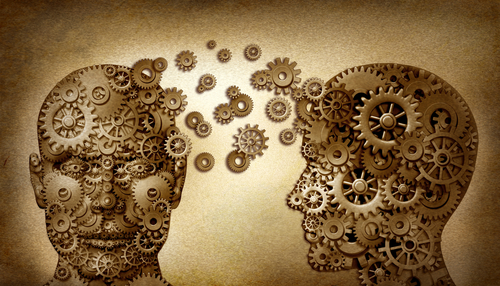
When a person experiences an unhelpful emotion (eg, depression or anxiety), it is usually preceded by a number of unhelpful self-statements and thoughts. Often there is a pattern to such thoughts and we call these, “unhelpful thinking styles”. One of the things we have noticed is that people use unhelpful thinking styles as an automatic habit. It is something that happens out of our awareness. However, when a person consistently and constantly uses some of these styles of thinking, they can
often cause themselves a great deal of emotional distress. This information sheet describes a number of “unhelpful thinking styles”. As you read through them, you might notice some thinking patterns and styles that you use consistently. Some of these styles might sound similar to one another. They are not meant to be distinct categories but to help you see if there is a kind of pattern to your thoughts.
This thinking styles involves a “filtering in” and “filtering out” process – a sort of “tunnel vision,” focusing on only one part of a situation and ignoring the rest. Usually this means looking at the negative parts of a situation and forgetting the positive parts, and the whole picture is coloured by what may be a single negative detail.
We jump to conclusions when we assume that we know what someone else is thinking (mind reading) and when we make predictions about what is going to happen in the future (predictive thinking).
This involves blaming yourself for everything that goes wrong or could go wrong, even when you may only be partly responsible or not responsible at all. You might be taking 100% responsibility for the occurrence of external events.
Catastrophising occurs when we “blow things out of proportion“., and we view the situation as terrible, awful, dreadful, and horrible, even though the reality is that the problem itself is quite small.
This thinking style involves seeing only one extreme or the other. You are either wrong or right, good or bad and so on. There are no inbetweens or shades of gray.
Sometimes by saying “I should…” or “I must…”
you can put unreasonable demands or pressure
on yourself and others. Although these
statements are not always unhelpful (eg “I should
not get drunk and drive home”), they can
sometimes create unrealistic expectations.
When we overgeneralise, we take one instance in the past or present, and impose it on all current or future situations. If we say “You always…” or “Everyone…”, or “I never…” then we are probably overgeneralising.
We label ourselves and others when we make global statements based on behaviour in specific situations. We might use this label even though there are many more examples that aren’t consistent with that label.
This thinking style involves asking your view of situations or yourself on the way you are feeling. For example, the only evidence that something bad is going to happen is that you feel like something bad is going to happen.
In this thinking style, you magnify the positive attributes of other people and minimise your own positive attributes. It’s as though you’re explaining away your own positive characteristics.
What are Core Beliefs?
You may have become used to the process of challenging your thinking in a range of situations. You know how to identify the thoughts that are causing you distress and how to challenge them and replace them with more balanced thoughts. However, you might notice that there are times when it is harder to believe the new balanced thought and the old unhelpful thoughts seem to be very powerful. You might notice that this happens in certain kinds of situations.
A possible explanation for this ‘difficulty in letting go’ of an unhelpful thought is that there may be a strong core belief at the root of that unhelpful thought. Core beliefs are the very essence of how we see ourselves, other people, the world, and the future. Sometimes,these core beliefs become ‘activated’ in certain situations. Here’s an example:
Erica is able to challenge her thinking in most situations. However, she has notice that she has trouble challenging her thinking in situations involving her flatmates and friends. In these situations, she has recognised that her thinking is often about being unlikable. In fact, when she really looks hard at her thinking, she can see that often the underlying self-statement is, “I’m unlovable.”
Core beliefs, such as the one from the above example, develop over time, usually from childhood and through the experience of significant life events or particular life circumstances. Core beliefs are strongly-held, rigid, and inflexible beliefs that are maintained by the tendency to focus on information that supports the belief and ignoring evidence that contradicts it. For example, Erica focuses on any feedback from her flatmates that isn’t positive and then uses this to confirm that yet again she is unlikable. Even neutral statements from her flatmates and friends are often interpreted as negative. Over the years, this narrow focus gives strength to the belief and Erica no longer thinks to question it. It is totally and absolutely accepted. It is not surprising, then, that these types of beliefs are the hardest to shake.
So, how can you start identifying your core beliefs? The first step is to look over your Thought Diaries to see if your ‘hot’ thoughts have any common themes. You might notice that there are certain patterns to your thoughts – similar themes that occur in the B columns. Looks closely at these to identify the patterns. You may become aware of one or two common themes found in the things you say about yourself, others, and the world.
The process of identifying a core belief is not a great deal different from what you have already being doing in your thought diaries. Essentially, the idea is to extend the hot thought further to reveal the bottom line or root of what you might be thinking. Use questions such as: “If that’s true, what does that mean?” “What’s bad about that?” “What does that say about me?” This process is like sifting through the layers of self-talk to get at what is at the bottom layer. Now, you are ready to challenge your beliefs. Even though these beliefs are strongly held, it is important that they are challenged, just like any unhelpful thoughts. Once you have fully identified what you are telling yourself, you can begin to see if your core beliefs hold up against all that you have experienced. This process of challenging your core beliefs may not be an easy one. If you find the process too difficult or distressing, do consider seeing a mental health professional and discussing with them.
To evaluate and challenge your core beliefs, ask yourself “What experiences do I have that show that this belief is not completely true all the time?” List as many experiences, and be as specific, as possible. Remember to write down everything even when you’re not sure if they are relevant.
When you have considered all the experiences you have written down, develop an alternative, balanced core belief. Remember that these experiences show that your unhelpful core belief is not completely true all the time. What would be an appropriate balanced and helpful core belief? Write this down.

You could also try doing a behavioural experiment to challenge those hard-to-budge unhelpful core beliefs. The purpose of doing an experiment is to find out how true your core beliefs are. Here’s how you could conduct an experiment.
-
-
- Write down the core belief you want to test
- Think of a few tasks you could do to test your core belief
- Write down what you would expect would happen if your core belief were true
- Carry out the tasks
- Record what actually happened when you carried out the tasks
- Compare the actual results with your prediction and write down what you might have learned from the experiment. Then, write down a new balanced belief that fits with your conclusion.
-
Following Through
You might find it useful to write your balanced core beliefs onto cards that you can carry around with you as a reminder when this type of thinking is triggered. Once you’ve developed balanced core beliefs, follow through on them. Balanced core beliefs require careful nurturing and ‘tender loving care.’ Affirm yourself by using positive self-statements, remind yourself of all the evidence against the unhelpful core belief. Also, act against your unhelpful core belief. Ask yourself, “If I really believed my balanced belief, what are the things I would do?” Then, go out and do them. The more you do these things, the more you will come to believe your balanced beliefs. Over time, these new core beliefs will be integrated into your belief system.
Problem Solving
Identify and Define Problem Area/Issue
-
-
- Try to state the problem as clearly as possible; be objective and specific; describe the problem in terms of what you can observe rather than subjective feelings
- Try to identify what is maintaining the problem rather than just what caused it
- Set realistic and achievable goals for resolving the problem
-
| Problem Definition | Maintaining Factors | Goals for Problem Resolution |
Generate Potential Solutions
-
-
- List all possible solutions without evaluating their quality or feasibility
- Eliminate less desirable or unreasonable solutions only after as many possible solutions have been listed
- Bearing in mind your goals for problem resolutions, list the remaining solutions in order of preference.
- Evaluate the alternatives
-
Decide on a solution
-
-
- Decide on one or two solutions
- Specify actions and who will take action
- Specify how and when the solutions will be implemented
-
Implement Solutions
-
-
- Implement the solutions as planned
-
Evaluate the outcome
-
-
- Evaluate the effectiveness of the solution
- Decide whether a revision of the existing plan is needed to address the problem better
-
Staying Healthy

Whatever form of treatment you have been receiving for your difficulties – medication or psychotherapy – it’s important that you maintain whatever gains you have made. If you have been seeing a mental health practitioner, keep practising the strategies you might have learned in therapy. This means continuing to apply all the useful skills and insights about yourself you might have gained and they will soon be integrated into your lifestyle.
There are also some other things you can do in order to make the most of what you have learned to stay well or gain that extra improvement. Here are some suggestions:
Keep to a balanced routine & lifestyle – A chaotic lifestyle can be stressful in itself. Try to keep to a reasonably structured routine and a balanced lifestyle. This means making sure you maintain good eating, sleeping, and exercising habits, and engage in social activities that can be both fun and challenging.
Develop a good social support network – It is wise to find someone with whom you can sit down and have a good talk. This doesn’t mean a therapy session where you pour out your heart but rather just a chance to talk through what’s going on in your life, what your goals are, and generally just to ventilate with someone you trust. Often problems seem bigger than they really are when a person tries to deal with them on their own. Hearing yourself talk through something can help to put it into perspective. Socialising is also fun and will help you to keep on track with scheduling of pleasant events.
Develop a good professional support network – Professional help is an important resource. Find a doctor or mental health practitioner with whom you can have a good professional relationship based on mutual trust and respect. Talk to them about your needs and concerns. Learn as much as possible about your illness and take an active role in making decisions about treatment and after-care.
Expect slip-ups and down days – Slip-ups in progress can happen at any time and are to be expected. Try not to fall into the trap of believing that you are ‘back to square one’ as this will only make you feel worse. Use your skills of challenging your thinking to help when this situations occurs. It might be useful to remind yourself that most people have ‘down days’ or days where life’s hassles are harder to deal with – it’s a part of being human! Also, you can use setbacks as a way of learning something new about yourself to help avoid similar problems in the future.
Remember – progress may be a bumpy road at times but it will be a rewarding journey on the whole!
